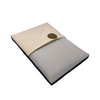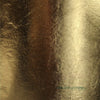Gold Leaf Across the World - Spain
- by Sam Wozniak
Gold Leaf in Spain: A Shimmering Legacy of Art, Faith, and Culture
Gold leaf — those whisper-thin sheets of pure gold — has long been a symbol of luxury, power, and divinity. In Spain, its story is especially rich, weaving through centuries of artistic mastery, religious devotion, and monumental architecture. From 24 carat brilliance to the more versatile 23.5 carat option, gilding has left its glowing mark across the country.
Let’s dive into the dazzling journey of gold leaf across Spain — where it came from, how it was used, and where you’ll still find it shining today.
When diving into the rich world of Spanish art, design, or even language learning, it's helpful to know how certain materials are expressed—especially ones as iconic as gold. In Spanish, gold is called "oro", a word as elegant and timeless as the metal itself. But when referring to gold leaf, the thin, delicate sheets used for gilding in artwork or decoration, Spanish offers two common phrases: "pan de oro" and "hoja de oro." While both are used to describe gold leaf, "pan de oro" is the traditional term most often seen in artistic contexts, whereas "hoja de oro" is a more literal translation. Understanding these subtle differences can add a deeper appreciation for both the language and the cultural uses of gold.
Where It All Began: Early Gilding in Spain
Spain's love affair with gold leaf began during Roman times. As the Roman Empire expanded into the Iberian Peninsula, it brought with it not just roads and aqueducts, but the refined art of gilding — applying thin gold sheets to objects and architecture.
Later, during the Islamic rule of Al-Andalus, new techniques and aesthetics were introduced. Islamic artisans, known for their intricate geometric designs and calligraphy, used gold leaf (often 23.5 carat or 24 carat) to elevate their works in palaces, mosques, and manuscripts.
These early influences laid the foundation for what would become a golden age—literally—in Spanish gilding.
Cathedrals, Retablos, and the Monumental Power of Gold
Fast-forward to the Gothic and Baroque periods, and you’ll find gold leaf practically everywhere — especially inside Spain’s awe-inspiring churches and cathedrals.
Take a walk into Seville Cathedral, Toledo Cathedral, or El Escorial, and you'll be surrounded by dazzling altarpieces, called retablos, covered in 23.5 carat gold leaf. These monumental masterpieces weren’t just about beauty — they were designed to impress, to inspire, and to reflect divine light.
The Catholic Church saw gold as a symbol of heaven. Gilding sacred spaces and religious icons helped bridge the earthly and the divine. The shimmer of gold leaf wasn’t just ornamental — it was spiritual.
Gilding Beyond the Church Walls
Gold leaf wasn’t only reserved for cathedrals and holy relics. During Spain’s Renaissance and Baroque periods, it made its way into homes, palaces, and workshops. Think ornate mirrors, carved furniture, leather-bound books, and picture frames — all glimmering with hand-applied gold leaf.
Craftsmen in cities like Madrid, Seville, and Granada developed their own gilding styles and techniques. 24 carat gold leaf was used for its unmatched purity and shine, while 23.5 carat gold leaf offered slightly more durability, making it ideal for wood, plaster, and leather surfaces.
Even cordovan leather from Córdoba — used for wall panels, book covers, and fashion — was often decorated with gold leaf accents, giving it a regal touch.
Gold Leaf Today: Tradition Meets Modernity
While the golden age of gilding peaked centuries ago, gold leaf is far from a lost art in Spain.
Restoration projects across the country continue to use traditional gilding techniques to bring historic buildings and artworks back to life. From the smallest chapel to the most monumental cathedral, 23.5 carat gold leaf helps maintain the authenticity of Spain’s cultural heritage.
Modern artists and designers are also embracing gold leaf in new ways — incorporating it into contemporary paintings, sculptures, and even architectural elements. It’s not uncommon to find workshops in Barcelona or Valencia where artists blend centuries-old gilding techniques with bold, modern aesthetics.
And yes — gold leaf has even made its way onto plates. In high-end restaurants, especially in tourist hotspots, chefs sometimes use edible 24 carat gold leaf to give tapas or desserts a glamorous twist.
A Golden Thread Through Spanish History
From ancient temples to cutting-edge art studios, gold leaf has always held a special place in Spain’s story. Whether in the form of delicate 24 carat purity or the slightly hardier 23.5 carat variant, gilding remains a powerful symbol of beauty, faith, and craftsmanship.
It’s more than just decoration — it’s part of Spain’s identity.
So next time you find yourself gazing up at a golden retablo or admiring the shimmer on a centuries-old frame, remember: you're witnessing a tradition that’s survived empires, inspired artists, and continues to shine through the ages.






